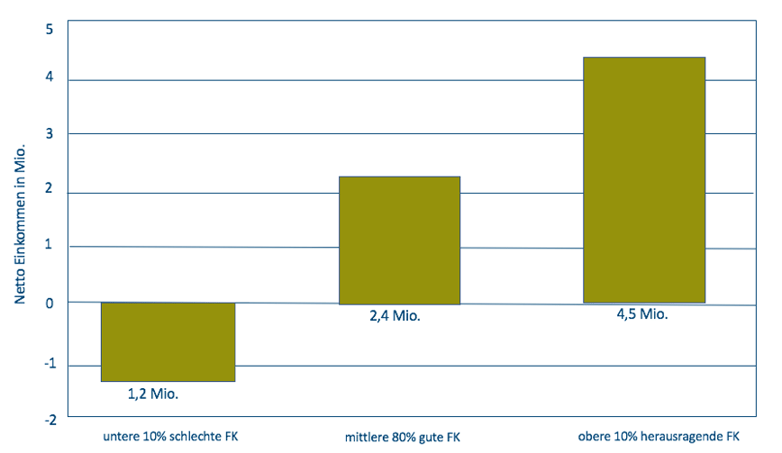How leadership styles achieve commitment and strong results
About leadership and the relationship between commitment and profitability
Leadership behavior has a significant impact on the profitability of the organization and employee engagement. In particular, 6 leadership styles lead to higher "commitment" and better results.
How exceptional executives can double the results
A study by Zenger & Folkman (2014) shows that there is a connection between management behavior on the one hand and the engagement and profitability of the organization on the other. This is not unusual in itself, everyone knows that dedicated employees usually perform better. However, the enormous differences in the results are interesting: While the lower 10% made an average net loss of USD 1.2 million in their area of responsibility, the middle 80% of managers made a profit of USD 2.4 million, the top 10% of the extraordinary "executives" almost doubled to USD 4.5 million, see Figure 1.

Of course, such studies always offer surfaces of attack: Employees are not the same, the context is different, the culture, strategy and structure of the organization are often very different. So would the same leaders achieve similar results under different circumstances? Due to the numerous variables, it is difficult at this point to actually find absolutely loadable material. However, patterns appear that can also be found in comparative studies, just think of the Gallup studies, which also show that a certain management behaviour goes hand in hand with high commitment, high employee satisfaction, low employee turnover and high customer satisfaction.
Two managers with different approaches
One is Thomas, the new "Vice President" for the Asian business of a global company. He took the job when the organization had just undergone restructuring. Of course, he had a whole series of challenges ahead of him. Thomas therefore felt it was important to form a team with a high degree of cohesion, a common sense in what they did and a strong connection to business in Asia. When Thomas was with the customer in Asia, his boss undercut the procedure and called it a pure waste of time. When Thomas returned to the office, he immediately confronted his manager, explained his actions and insisted on continuing along the path he had taken.
Confronting the boss was more than unusual. To everyone's surprise, the "big cheese" changed his mind and Thomas was able to continue on his chosen path. In the following year, the results were significantly higher than those of the previous year.
On the other hand, let's look at Caroline, a tough marketing woman who was very competitive and who liked to challenge her managers with questions and lonely decisions. She was known for relatively ruthlessly "developing" employees who did not always agree with her. Their "meetings" were feared and it often happened that employees were treated disrespectfully before everyone else. Although it was analytically and strategically very strong, after initial successes in the first 12 months more and more warning signals arose: Loyal managers left the division or even the company as a whole, sentiment became corrosive, business stagnated and profits were close to zero.
While Thomas left behind a committed and motivated team, Caroline's employees only remember this time with horror.
Which leadership styles are proving particularly promising?
Both examples show behaviours that are quite common in everyday business life. Of course, they represent extreme poles rather than mediocrity. In their studies Zenger and Folkman come up with six behaviours that have a particularly positive effect on the results and at the same time the commitment of the employees.
- Balance between result-orientation and inspiration: Again and again you meet managers who create strong pressure in the sense of result-orientation ("push mode"), but have little inspiration ("pull mode"). This greatly reduces motivation in the long run. A healthy balance (keyword: balanced leadership) therefore makes sense.
- Strategic perspective: Successful leaders make clear to their organization where they want to go and what steps they can take to achieve this goal. This makes their personal value contribution to the success of the organization evident to employees.
- Collaboration: When leaders demonstrate that working together makes it possible to achieve goals and that this requires intensive interaction between all participants, synergy and fun arise at work.
- Trust: Trust is the lubricant of organizations. Leaders build trust by acting honestly and with integrity, empathizing with their employees and acting consistently and congruently.
- Development and growth: Everyone normally wants to grow and develop. Outstanding leaders are committed to developing their people and helping them grow.
- Courage: Successful managers courageously tackle change. They recognize conflicts and address problems immediately. They also insist that everyone assumes their responsibility.
Conclusion:
The mixture and balance is what makes leadership successful: Being able to build trust, have a clear vision of the future, act competently and with integrity, work on an equal footing, support employee development, be courageous enough to leave familiar paths and live a healthy balance between inspiration and results orientation.
From our experience, two important aspects for realistic success in today's working world should be supplemented: Leaders should make processes agile and build their organization as adaptively as possible to meet the given requirements of increasing dynamics and complexity.
If you want to qualify your managers successfully, please ask for our expertise. On the basis of modern management concepts we are at your disposal with words and deeds.
Literature:
Zenger, J. & Folkman, J. (2014). How excellent leaders double profits. Whitepaper.

